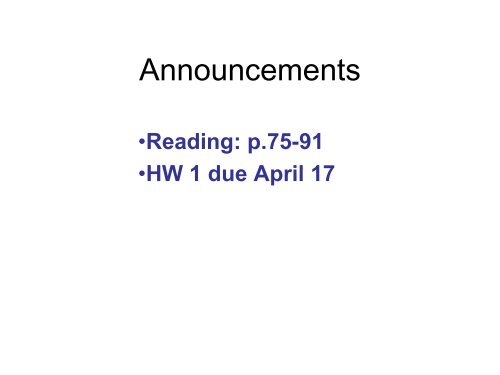(beginning of melting) for granodiorite
(beginning of melting) for granodiorite
(beginning of melting) for granodiorite
Create successful ePaper yourself
Turn your PDF publications into a flip-book with our unique Google optimized e-Paper software.
Announcements<br />
•Reading: p.75-91<br />
•HW 1 due April 17
Crater Lake, OR<br />
Deepest lake in N.<br />
America: 1932 feet<br />
Eruption 7000 years b.p. reduced 12000 ft (3700 m) tall mountain<br />
to caldera about 6100 ft above sea level
Harker diagrams<br />
<strong>for</strong> Crater Lake<br />
What features do<br />
you observe in these<br />
diagrams?<br />
(X, Y, data clusters)<br />
Primary, parental,<br />
primitive, and<br />
evolved magmas<br />
Figure 8-2. Harker variation<br />
diagram <strong>for</strong> 310 analyzed volcanic<br />
rocks from Crater Lake (Mt.<br />
Mazama), Oregon Cascades. Data<br />
compiled by Rick Conrey<br />
(personal communication).
Harker diagram<br />
<strong>for</strong> Crater Lake<br />
Describe trends<br />
qualitatively with<br />
fractional crystallization<br />
• Trends = liquid line <strong>of</strong><br />
descent<br />
• The most primitive<br />
lava on the diagram is<br />
the parent magma<br />
• What phases typically<br />
crystallize from<br />
magmas?<br />
• Adjust % <strong>of</strong> remaining<br />
components (Na, K)<br />
Figure 8-2. Harker variation diagram <strong>for</strong> 310<br />
analyzed volcanic rocks from Crater Lake (Mt.<br />
Mazama), Oregon Cascades. Data compiled by<br />
Rick Conrey (personal communication).
• Fractional<br />
crystallization?<br />
• Partal magma<br />
mixing?<br />
• Oxide<br />
crystallization?<br />
The Daly Gap
Ocean-ocean → Island Arc (IA)<br />
Ocean-continent → Continental Arc or<br />
Active Continental Margin (ACM)<br />
Figure 16-1. Principal subduction zones associated with orogenic volcanism and plutonism. Triangles are on the overriding<br />
plate. PBS = Papuan-Bismarck-Solomon-New Hebrides arc. After Wilson (1989) Igneous Petrogenesis, Allen Unwin/Kluwer.
Structure <strong>of</strong> an Island Arc<br />
Figure 16-2. Schematic cross section through a typical island arc after Gill (1981), Orogenic Andesites<br />
and Plate Tectonics. Springer-Verlag. HFU= heat flow unit (4.2 x 10 -6 joules/cm 2 /sec)
Continental Arc<br />
Magmatism<br />
What components<br />
contribute to melts that<br />
end up erupting or<br />
stagnating in the crust?<br />
What processes can<br />
induce <strong>melting</strong>?<br />
Figure 17-2. Schematic diagram to illustrate how a<br />
shallow dip <strong>of</strong> the subducting slab can pinch out the<br />
asthenosphere from the overlying mantle wedge.<br />
Winter (2001) An Introduction to Igneous and<br />
Metamorphic Petrology. Prentice Hall.
Components that contribute to<br />
continental arc melts<br />
• Continental crust<br />
• Mantle wedge<br />
• Subducting lithosphere
Volcanic rocks in island arcs and<br />
continental arcs vs. other localities<br />
Sub-alkaline series<br />
Tholeiites (basalts)<br />
**Calc-alkaline magmas:<br />
enrichment in SiO 2 ,<br />
FeO*/MgO, and H 2 O (K 2 O<br />
more complicated) relative<br />
to tholeiites<br />
(Andesites, dacites)<br />
Alkaline magmas<br />
(rhyolites)
Mantle Wedge<br />
• Composition:<br />
ultramafic<br />
• Flow lines generally<br />
downward<br />
• Sitting above colder<br />
subducting crust- how<br />
do we initiate <strong>melting</strong><br />
in mantle wedge?
Subducting lithosphere<br />
• Again, it’s cold- why<br />
would it melt?<br />
• Can we figure out a<br />
way to determine how<br />
much the subducting<br />
slab is contributing to<br />
the melt?
Dehydration reactions in a<br />
subducting slab<br />
• What minerals are<br />
present in top/middle<br />
<strong>of</strong> oceanic lithosphere<br />
be<strong>for</strong>e subduction?<br />
• Clays, micas,<br />
carbonates, sulfates,<br />
amphiboles (as P<br />
increases)<br />
Mg 7 Si 8 O 22 (OH) 2 = 7MgSiO 3 + SiO 2 + H 2 O
Dry and water-saturated<br />
water saturated solidi <strong>for</strong> some common rock<br />
types<br />
The more mafic the rock<br />
the higher the <strong>melting</strong><br />
point<br />
All solidi are greatly<br />
lowered by water<br />
Figure 7-21. 7 21. H2O-saturated saturated (solid)<br />
and H 2O-free free (dashed) solidi<br />
(<strong>beginning</strong> <strong>of</strong> <strong>melting</strong>) <strong>for</strong><br />
<strong>granodiorite</strong> (Robertson and Wyllie,<br />
1971), gabbro (Lambert and Wyllie,<br />
1972) and peridotite (H 2O-saturated: saturated:<br />
Kushiro et al., al. , 1968; dry: Ito and<br />
Kennedy, 1967).
The effect <strong>of</strong> adding a little water to<br />
• Induce <strong>melting</strong> simply by<br />
adding water, instead <strong>of</strong><br />
increasing temperature<br />
• A few wt% <strong>of</strong> water has a<br />
larger affect than a few<br />
wt% <strong>of</strong> common cations.<br />
• H 2 O = 18.01<br />
• FeO = 71.85<br />
the mantle wedge
Q: How much fluid/sediment from the<br />
subducting slab gets into the final melt?<br />
• Boron: tracer <strong>of</strong><br />
sediments<br />
• 10 Be: produced in the<br />
atmosphere (O,N): tracer<br />
<strong>of</strong> seafloor sediments and<br />
rate <strong>of</strong> subduction – t 1/2 <strong>of</strong><br />
1.5 ma<br />
• A: Not sediment itself.<br />
Some, but not all <strong>of</strong> fluid.<br />
• Does all the water come<br />
out? Does some keep<br />
going into the mantle?<br />
How?
100 mi /161 km<br />
Cali<strong>for</strong>nia Regions<br />
http://photojournal.jpl.nasa.gov/catalog/PIA03333<br />
SF<br />
9<br />
1<br />
10<br />
2<br />
1<br />
11<br />
3<br />
5<br />
LA<br />
Ca Geology, Harden<br />
8<br />
4<br />
6<br />
7
CA<br />
Geologic<br />
Map<br />
http://geology.about.com/library/bl/maps/blcali<strong>for</strong>niamap.htm<br />
125-88 Ma




